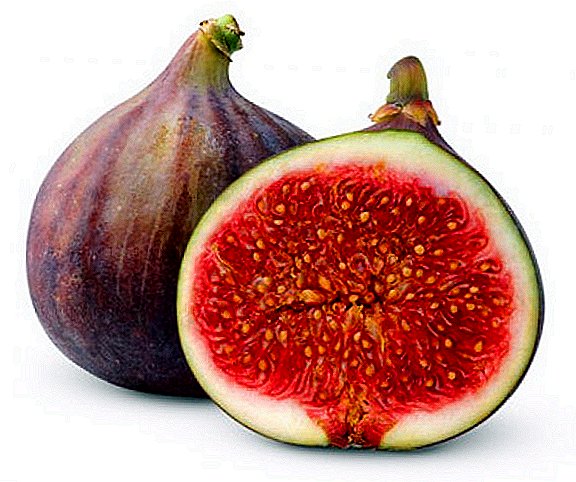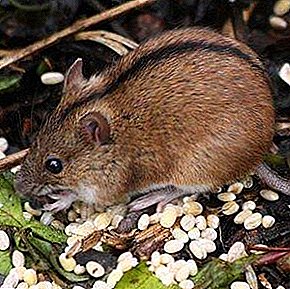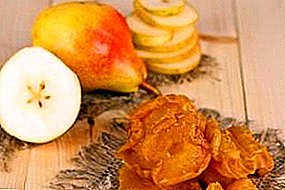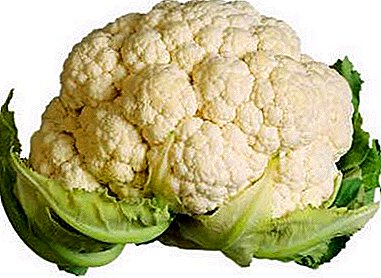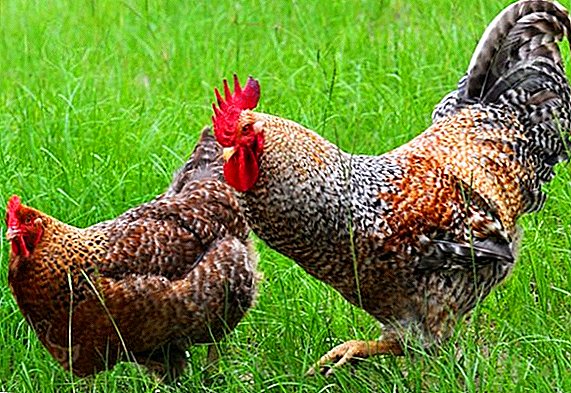 German chicken breeds are very popular with modern and experienced poultry farmers.
German chicken breeds are very popular with modern and experienced poultry farmers.
Wonderful glory goes about them: productive, beautiful, well adapted to new conditions.
Let's take a closer look at what features different representatives of German chickens have.
Features of German breeds
The main feature of German breeds of chickens is that they are very beneficial for any poultry farmer.
German chickens:
- carry a lot of eggs
- have an impressive weight
- have a beautiful appearance
- well and quickly get used to different living conditions.
German breeds of chickens
The following 9 breeds are considered to be the most common among hens of German origin.
Loman brown
Loman Brown is not a shy breed. Birds are distinguished by sociability and desire for communication. When breeding them, an almost perfect ratio of the money spent on feed and the number of eggs laid is obtained. 
Brown crow banana weighs an average of 3 kg, and chicken - about 2 kg. Birds carry eggs already in 5.5 months. Eggs are durable, medium size, weight is about 64 g, the color of the shell is light brown. One chicken carries about 315-320 eggs per year. Brown chicks are characterized by a high viability index (98%).
Sexual maturity in these birds comes in 135 days, and chickens grow 161 days. After 80 weeks of productive egg-laying, quantitative indicators decline. Broken brown chickens can live in any conditions - they grow and develop equally well in cages and in the wild, in industrial content and in private.
Hamburg
Individuals of the Hamburg breed are graceful, beautiful and elegant birds. They have a medium high figure and a long body. Plumage - black and white, decorative. Hamburg chicken always looks rich, proud and noble.
Did you know? Hamburg breed of chickens began to withdraw in the 40s of the XVIII century.Her scallop is pink with a distinct bright tooth in the middle, pointing back. The earlobes are white. At the beak and fingers a slate-blue color.

Breed features:
- live in any conditions;
- grow rapidly;
- possess high rates of egg production;
- stand frosts;
- adapt quickly to change.
Such breeds of hens as the brahma, Legbar, Poltava, Moravian black, and Pushkin differ in high egg production.
Hamburg chickens have a high survival rate (80-85%). Adult cock weighs from 2 to 2.5 kg, and adult chicken - from 1.5 to 2 kg. Hamburg layers are prolific: they give from 160 to 180 eggs in the first year of life and 140 - in the second. Eggs weigh 55 g, the shell is white.
Important! Hamburg chickens do not hatch their eggs, so for their breeding you must use an incubator.
This breed requires spacious enclosures that will be connected to poultry houses. It is necessary to arrange their seats. Perches must be made from natural material. 
Hamburg roosters are fairly balanced, peaceful and calm, with other roosters do not get into conflict. These birds are very active, they need constant long-term walking and communication. The feed intake is low, which makes the cultivation of this breed very beneficial for any host.
There are several breeds of chickens, similar in characteristics to Hamburg:
- Russian white;
- May Day;
- Leningrad calico.
Did you know? Hamburg chickens live with real families, where the head of the family is a rooster.
Forever
Forverk breed was bred in 1900 in Germany. The result of the work of breeders - fast-growing birds with royal plumage. Roosters weigh up to 3 kg, and chickens up to 2.5 kg. 
Layers are able to carry about 170 eggs in the first year of sexual maturity and 140 eggs in the second. Eggs have a weight of 55 g and a slightly yellow shell.
Forverki have a dense and coarse physique. The body is wide, the body is located low. These birds are slightly angular and have a broad back. On the face of red you can see a little plumage. The eyes are characteristic - large, orange, expressive.
The small and simple comb has from 4 to 6 teeth. The earlobes are oval and white.
Chickens are more massive than cocks, they have big and strong breasts. The color of the neck, tail and head is black. The body has a noble color of old gold. On the outer side, the wings are yellow in color, and on the inner side, they are yellow-black or black-gray. Down in a rooster - light blue. 
The character of the Forks is balanced and trusting. Very quickly they remember the owner, recognize him, go to him in his arms, become attached. They are peaceful, so get along with other breeds in one area.
Important! Breed forvork is not important walking in the fresh air, so it is suitable for industrial breeding and cultivation in cages.
Chickens forverk badly tolerate sudden changes in temperature and humidity, which means that you need to constantly monitor their conditions of detention. Be sure to require full and proper feeding - frequent consumption of protein foods and vitamins.
Annaberger Crested Curly
These decorative birds are distinguished by their rarity.
The decorative breeds of chickens include such people as Paduan, milfleur, Pavlovsk.
Brought them relatively recently - in 1957. As the name implies, birds have beautiful curly plumage. The color of feathers is white, black and silver. Of the decorative features can be noted crest and scallop in the form of a horn. 
The character of annabergera is inquisitive, friendly, sociable. Adult cocks do not weigh more than 1.5 kg. Chickens weigh a little less and carry an average of 120 eggs per year, the shell is white or cream.
Did you know? Annaberger Crested and Curly is one of the few German breeds that lay eggs and take care of chickens.
Rhine
The Rhine Hens is a meat-and-egg breed. They received their name in honor of the River Rhine in Western Europe. The creation of the breed dates from the XIX century. It appeared as a result of crossing chickens that live near the German Eifel mountain range and Italian birds.
Rhine chickens come in different colors:
- white;
- black
- blue;
- brown;
- Colombian;
- kuropchatogo;
- spotted black and blue.

Representatives of this species have a specific wide back, strong body and massive chest. They have a special crest, characteristic only of the Rhine hens. The earlobes are white and small. These birds are unpretentious, do not need special care. They have good health and easily adapt to new weather conditions.
Did you know? In 1908, the Rhineland hen won the first egg laying contest held in Germany.
Possess appeasable character, friendly to people and trusting, quickly remember the owner. They are active and energetic. Like many other purebred chickens, the Rhineland do not hatch eggs. About 180 eggs per year are carried, each weighing from 55 to 60 g. The rooster weighs 2.75 kg and the chicken weighs 2.5 kg.
Important! Rhenish chickens pugnacious, can peck each other. It is necessary to closely monitor the relationships of birds in the hen house.
Chickens and roosters of this breed have 4 toes on their paws. They can fly for short distances and overcome a height of up to 1 m. For these birds it is very important to arrange the house correctly, because not only the favorable condition of the chicken, but also the number of eggs it will bring depends on it. 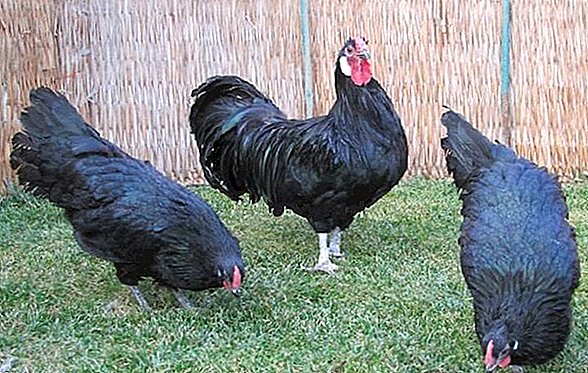
Ideal Rhine chickens to poultry farmers who want to get eggs and meat.
Important! It is necessary to monitor the feeding of these chickens, because with an insufficient amount of birds, they can stop egg-laying before the onset of better times.
Ostfriz gull
Ostfrizian gull is one of the most ancient breeds obtained by German breeders. Now they are getting less and less, they are gradually dying out. Although they are a breed with high productivity in terms of both meat and eggs, more productive and resistant species gradually take their place.
The nature of the birds is calm and good-natured. They can be kept together with other breeds. Independently incubate the eggs and take care of the chicks. Chickens breed Ostfrizian gull are resistant to changing conditions: well perceive frosts and sudden changes in temperature. 
Because of the thick plumage, it is easier for them than for other breeds to keep the body warm. Their only obvious disadvantage is that they fly well, so they can get lost or become prey for predators.
Important! Young Ostfrizian chickens do not tolerate high humidity, which promises the need for additional care and mandatory maintenance in a dry place.
Ostfrizian chickens will feel good in a spacious poultry house with a large place for walking in the open air. Birds love to eat grass and breathe fresh air, which affects the quality and quantity of eggs laid. Fed them with special mash.
Important! Roosters of this breed feed separately from laying hens, since it is necessary to add egg shells and chalk in large quantities to the feed.
Roosters weigh from 2.2 to 3 kg, and laying hens weigh up to 2.5 kg. In the first year of laying eggs, chickens lay about 180 eggs, each weighing 50 g. 
Westphalian Totleger
The Westphalian Totleger is a rare breed of German chickens. They, like the Ostfrizian seagull, are gradually being replaced by more successful and productive breeds. These birds continue to breed exclusively for the sake of preserving the population.
The body of the Westphalian rooster is dense and rounded. The bird has a very bright and fluffy plumage. On the neck of a medium length there are long feathers, and on the waist a long plumage falls on the wings. The face is red, there are no feathers on it.
The earlobes are bright white, oblong. The color of the Westphalian Totlegger can be either white with black or red.
Did you know? The word "Totleger" from German translates as "layer that can lay eggs until death."
This breed is perfect for those who keep chickens in order to get eggs. After all, they actually carry eggs until death. Give up to 150 eggs per year. 
These birds are very active, love to move a lot, sit on elevations and inspect their territory. On it, they do not tolerate other species of birds - they behave aggressively with them, attack.
They love to fly and do it well, so you need to follow the proper arrangement of the paddock - you need a roof or a shed.
Birds are accustomed to frequent feeding with pasture. Therefore, in winter, the Westphalian Totlegers need to be fed with insects and fresh greens, which can be replaced with special vitaminized supplements. An adult rooster can weigh up to 2 kg, and chickens gain weight up to 1.5 kg. Egg weight - 50 g
Bielefelder
Bielefelder is a breed of chickens that was bred in the 70s of the last century. Refers to meat and egg chickens. It has a bright decorative colors. 
Breeds that were used to breed bielefelder chickens:
- Velzumer;
- amrox;
- Rhode Island;
- new hampshire;
- Malin
These chickens have an autosex color, which makes it possible to detect their sex already on the first day of life. Roosters are ocher-yellow with brown stripes on the back and a white spot on the head. Chickens are light brown with dark brown stripes on the back and a small white speck on the head.
Features breed Bielefelder:
- grow rapidly;
- resistant to diseases;
- their meat is tasty;
- produce many eggs;
- resistant to frost.

They have large eggs, have the correct form. The nature of the birds is calm, they are sociable and moderately curious. Do not fly. From 180 to 230 eggs per year. Eggs weigh at least 60 g, and normally - 70 g.
Important! It is necessary to keep the bielefelder chickens separate from other breeds or to follow the relations in the house, as the bielefelder is very slow and may simply not have time to eat food.
The shell is light brown or brown. Egg production rates fall in the third year after puberty. Roosters weigh up to 4.5 kg, and chickens can grow up to 3.5 kg.
Sundheimer
Sundheimer is a popular, but very rare European breed. They began to withdraw them in 1890. These chickens are ideal for domestic poultry farming, as they will provide the host with tasty meat and lots of eggs. 
The body of these birds is dense and muscular, the neck is wide, moderately covered with feathers. The back is flat, of medium length. The comb has a leaf shape, it has from 4 to 6 spines. The cover of the feathers at the Sundheimers is not very thick. Until the 12th week it is very difficult to distinguish a rooster from a chicken.
Did you know? Sundheimer is listed in the Red Book as an endangered species.
Color feathers - light black and Colombian. White or silver-white under plumage. Birds carry eggs well in winter, incubate their chickens and do not leave chicks. The character is calm, peaceful, but it’s not easy for them to contact people.
The plumage of the Sundheimer breed is rare and grows slowly, so in winter the birds need to create warm indoor conditions. Also from time to time it is necessary to change the rooster, which insects chickens to prevent the appearance of dwarf or defective birds. 
Birds are well adapted to the proposed living conditions. They will feel great in a confined space, and if possible walking in the fresh air.
Important! If you want to gain confidence from the Sundheimer chickens, buy them at the age of several weeks and feed them yourself.
German breeds of chickens will be very profitable and the right solution for poultry farmers. They combine the best qualities of different breeds of chickens: excellent adaptability, tasty meat, great egg production rates and beautiful appearance. It remains only to choose a breed that is ideal for the conditions that the breeder can offer them.


